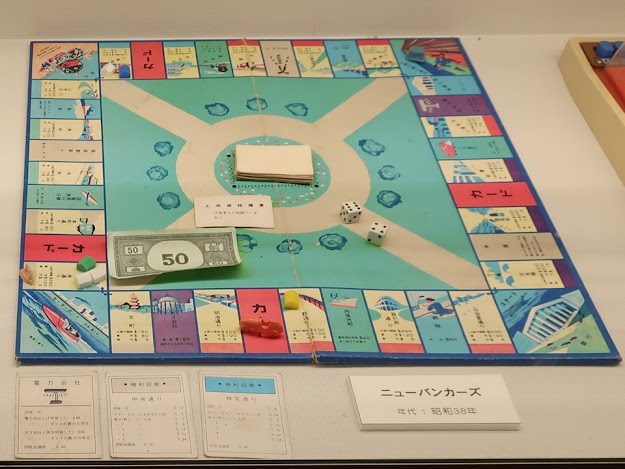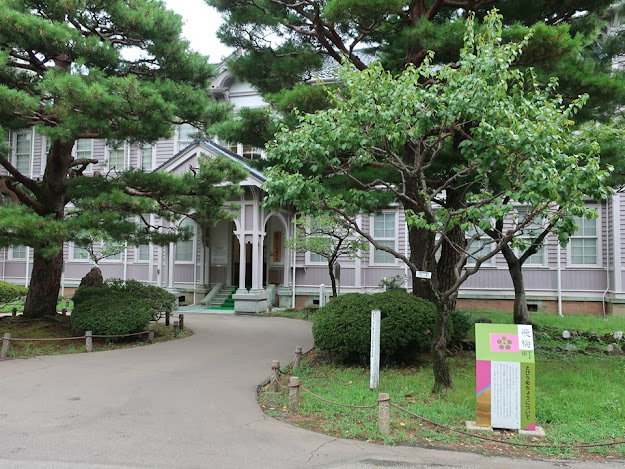It says on the brochure “The daimyo lord Maeda clan introduced culture of Kyoto (which has lots of art crafts such as luxurious fabrics), therefore various traditional crafts were created in Kanazawa where samurais accounted for half of its population. The customs and lives in Kanazawa are shown here.
藩主前田家が「京文化」を熱心に取り入れ、様々な伝統産業を生んだ金沢は、人口の半分近くを武家が占めた、とリーフレットに書かれている。金沢の風習や生活が展示されている。
The building of this museum was a junior high school which was built in 1899. It’s charming.
博物館は明治32年(1899年)完成の中学校校舎を利用している。瀟洒な洋風校舎だ。
 |
| Entrance、玄関 |
Art crafts、工芸品のコーナー
“Kaga-zougan” is made by carving a design into the base metal and inlaying gold or silver. Yonezawa family made them as a manufactural studio of Kaga-han (local government int the Edo period). Their crafts are exhibited. |
Killer whale shaped object (may be an incense burner)
大海炉(鯱/しゃち)、香炉のようです
|
 |
Tools to make wooden crafts. K.Himi, who
was designated as an important intangible cultural asset, used these tools. 木工芸。人間国宝・氷見晃堂氏の道具。
|
Life before WWⅡ、戦前のくらし
Fishing gear for hobby: Fishing rods and flies made in this region “Kaga” are called “Kaga-sao” and “Kaga-kebari” are gears that amateur fishermen long to have. Those are exhibited in Ishikawa Prefectural Museum of Traditional Arts and Crafts, too. The length of the ayu (sweetfish) pole is adjusted by the number of rods. The joints are reinforced by Japanese lacquer which is also a specialty of this region.釣り道具。加賀竿と毛針は、釣り人の憧れの一つのようだ。県立伝統産業工芸館にも展示されている。鮎竿は必要な長さに継いで使う。継ぎ口は漆で補強しているという。
 |
Kaga-kebari (Fries) are used to fish ayu mainly. These collections
imagine me the fishing scene in the river.
加賀毛針は主に鮎釣り用。こういうコレクションは、釣りの様子を思い起こさせて実に楽しい。
|
In the showcase below, seasonal traditions are exhibited. From left, Konpeitou sugar confectionary used at Girls’ festival “Hina-matsuri” in March. The snow, which is stored in the end of January, is taken out in the end of June. People eat Himuro manjyu (sweet bean-jam bun) on the 1st of July while praying for good health. In the autumn, they made Oshi-sushi for the autumn festival. It says those are made through processes of placing vinegared fish such as mackerel over vinegared rice, placing shrimp and dark blue seaweed and pressing them. In the winter, they use hibachi brazier. The decorated one by lacquer and gold is displayed. They enjoy each season.
 |
| Oshi-sushi、お祭り料理の押し寿司 |
3月の金花糖、ひな祭りに飾られる砂糖菓子。6月は氷室開き。1月末に詰めた雪を6月末に取り出す。7月1日には無病息災を願い氷室饅頭を食べる。秋は、秋祭りの押し寿司用の木枠。押し寿司は、酢飯に、春は鰯、秋は鯖などを並べて、海老・紺のりを載せて、重しをかけて作る。発酵はさせないようだ。冬は、蒔絵を施した桐火鉢。雪国金沢の四季それぞれの楽しみがある。
The bedroom in summer. When I was a child, a mosquito net (kaya) was still used. Sleeping under it gave me special feeling. You can put on yukata (Japanese nightwear) and take photos here.
蚊帳の中で寝るのは特別な感覚があって、何か楽しいものだった。浴衣を着て撮影できる。
Toys、おもちゃ
 |
Local toys, everything is well made. 郷土玩具。どれも良く出来ている。
|
The toy showcase at the exhibition room of the life after WWⅡ. These toys bring back a lot of memories.
戦後のくらしの展示室のおもちゃの棚。私が遊んだおもちゃも多い。
 |
Baseball game (around 1977), every boy was a baseball boy. On the rainy day, we
played in the house. 野球盤ゲーム(昭和52年頃)、あの頃みんな野球少年だった。
|
 |
Basketball game (around 1965)
ニューバスケットボールゲーム(昭和40年代)
|
 |
This was a very popular board games, “Bankers”.
We competed to make money. よく遊んだバンカース(昭和38年)。絵が懐かしい。
|
 |
| Dolls for girls are also made crudely. |
 |
Miniature furniture for playing house (around 1960); we
longed for western lifestyle.
ままごと用のミニチュア。リカちゃん人形といい洋風生活に憧れていた。(昭和30年代)
|
Festival、祭りの展示室
 |
You can put on festival gear such as Happi
coat and take photo here.
祭の衣装を着て写真を撮るコーナー。
|
 |
The parade of Kaga-tobi firefighters with
Happi coat; We can wear their outfits.
|
 |
We can also put on lion dance outfit here.
獅子舞の衣装も着ることができる
|
Special exhibition: Kitchen in the Showa period (1926-1989)、企画展:昭和の台所
The dinner table is shown at the front. Models of meals are exhibited with tableware, those are interesting. The signboard says “Photo spot”, we can take photos freely here.まずは、食卓風景。道具とともに当時の食事が展示されているのが面白い。「記念撮影スポット」の立て札があるが、撮影自由。
 |
Rusty cuisine in the early Showa period
(early 20th century); they rarely ate meat.
シンプルな昭和の家庭料理。肉が少なかった。厚揚げと酢の物。
|
 |
Apronlike garment called Kappou-gi; my mother wore it.
かっぽう着
|
 |
The lunchbox was made from woods, but the
material changed to aluminum (alumite)、弁当箱は木製だったが、昭和中期にアルマイト製に。
|
The classroom is rebuilt. Everything is new and bright colour.
再現された中学校の教室。部屋も机も真新しい。
This is the wall of the former Head Okumura Family House. Okumura was the executive vassal. The end of this street is the castle. Now there is a hospital inside this wall.
近くには加賀八家「奥村家(宗家、一万七千石)」屋敷跡がある。突き当たりはお城である。今は病院になっている。
 |
Tsutsumi
drum gate of Kanazawa station.
金沢駅の鼓門。武家が多い金沢で栄えた能の鼓をモチーフにした柱が特徴で金沢駅のシンボルマークとしてすっかり定着している。
|
8 funs(楽fun)were found. Visited in August, 2019
Official website:
https://www.kanazawa-museum.jp/minzoku/english/index.html (in English)
https://www.kanazawa-museum.jp/minzoku/ (in Japanese)
accessed in September, 2020
Previous post (Old merchant house museum in Kanazawa):
Kanazawa Shinise Memorial Hall 金沢市老舗記念館
Next post (Museum in the neighboring prefecture of Kanazawa):
Takaoka Municipal Museum & Casting Museum 高岡市立博物館と高岡鋳物資料館













Comments
Post a Comment